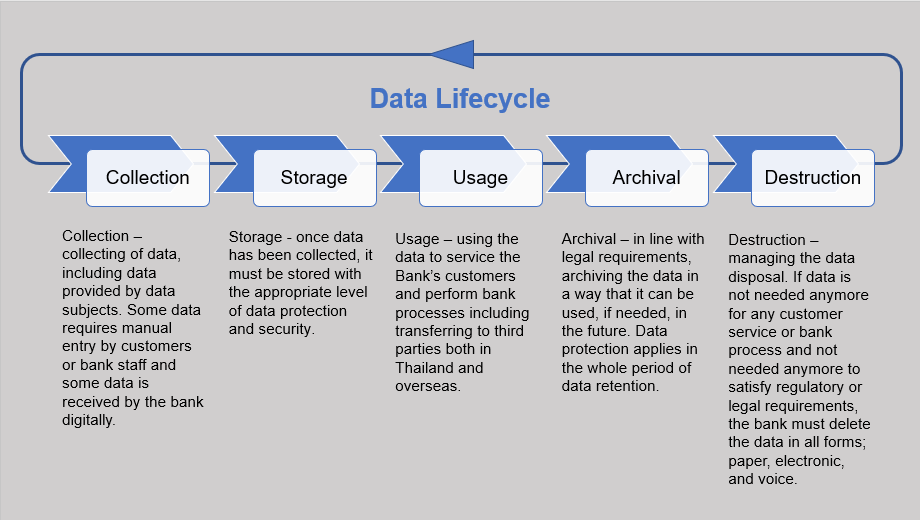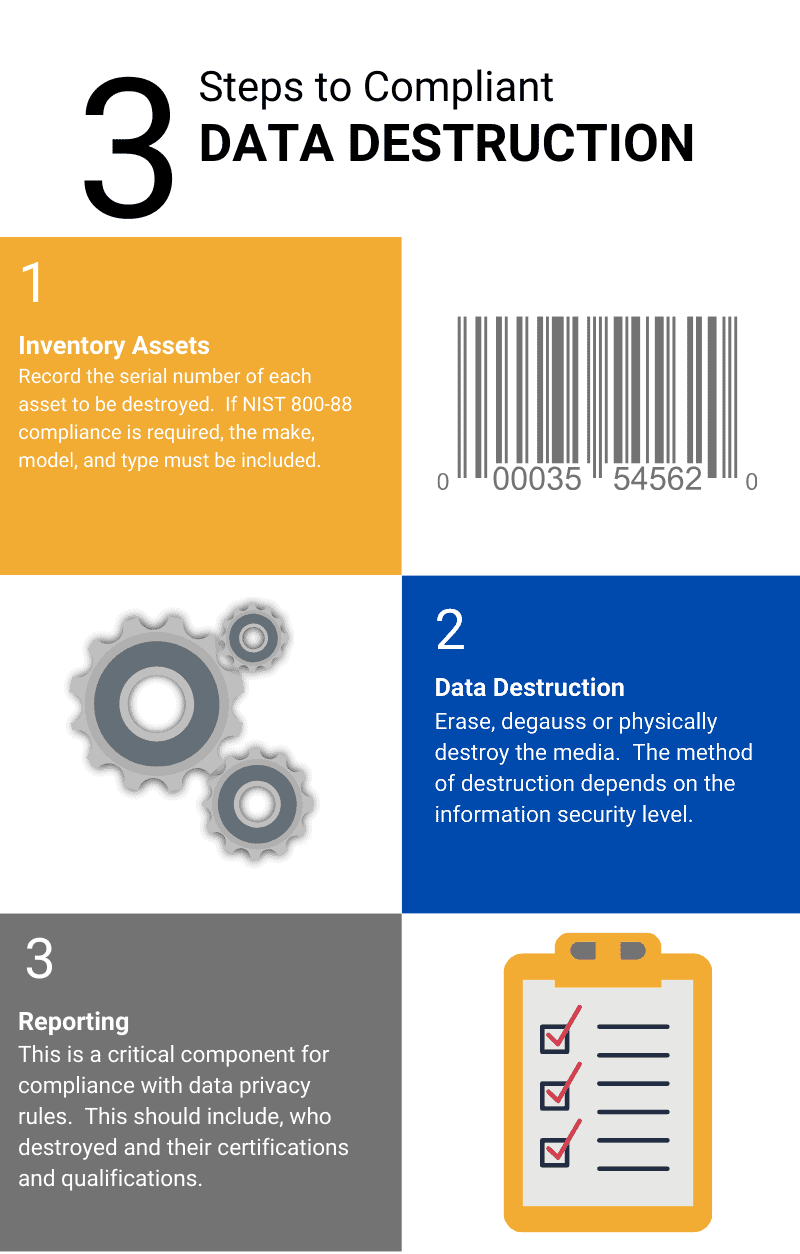Why Data Destruction is an Essential Part of Comprehensive Cyber Security
Wiki Article
The Essential Nature of Data Devastation in Upholding Computer Safety And Security Services and Protecting Versus Unauthorized Accessibility
In a period where data violations and identification burglary are progressively widespread, the value of reliable information devastation can not be overemphasized. Organizations has to identify that the failure to appropriately deal with sensitive details poses not only legal and financial threats however likewise a prospective erosion of customer depend on. Various techniques, from information wiping to physical devastation, work as essential safeguards versus unapproved gain access to. Comprehending the implications of information damage techniques and compliance with regulations raises vital concerns regarding the competence of present approaches and their long-lasting practicality in the face of advancing threats.Significance of Information Devastation
In an increasingly electronic globe, the significance of information damage can not be overemphasized. As organizations accumulate huge quantities of delicate info, the possible repercussions of failing to correctly handle and dispose of that information end up being increasingly extreme. Information breaches, identity theft, and company espionage position substantial risks, highlighting the need of effective data damage techniques.
Additionally, as modern technology progresses, so too do the approaches by which destructive stars look for to exploit sensitive information. Organizations should continue to be watchful and proactive in their data destruction approaches to safeguard versus these evolving dangers. By prioritizing information destruction, business not just protect their assets but also foster depend on among stakeholders and clients, showing a dedication to responsible information monitoring and safety techniques.
Methods of Effective Data Devastation
To ensure the total and permanent damage of delicate information, organizations can use a variety of effective methods tailored to their certain needs. One of the most usual techniques is information cleaning, which includes making use of specialized software program to overwrite existing data multiple times, making recuperation essentially difficult. This is especially valuable for disk drives and solid-state drives, where conventional deletion approaches are inadequate.An additional reliable approach is degaussing, which makes use of strong electromagnetic fields to interfere with the magnetic domains on storage space media, making the information irretrievable. This technique is specifically matched for magnetic storage space devices, such as tape drives and hard drives.
Physical devastation is likewise a sensible alternative, including the shredding, crushing, or incineration of storage gadgets. This method warranties that data can not be recovered, making it perfect for organizations managing highly sensitive details.

Compliance With Information Protection Rules
Organizations have to not just concentrate on efficient information damage techniques however likewise make certain conformity with information security regulations that govern exactly how sensitive details is managed and thrown away. Complying with these policies is essential for protecting individual data and preserving customer trust. Rules such as the General Data Protection Law (GDPR) in the European Union and the Wellness Insurance Coverage Transportability and Accountability Act (HIPAA) in the United Your Domain Name States enforce strict standards on information management, that include needs for the secure disposal of delicate details.To attain conformity, organizations should carry out comprehensive data damage policies that straighten with these legal structures. This includes identifying information that calls for devastation, developing procedures for safe methodsâEUR" such as shredding physical media or making use of software that meets industry standards for information wipingâEUR" and maintaining thorough records of devastation tasks. Routine audits should be conducted to make certain adherence to these policies and to recognize any type of potential areas for renovation.
Failing to conform with data security guidelines can result in significant lawful ramifications, consisting of significant fines and damage to an organization's reputation. Consequently, integrating compliance right into data devastation practices is not only a lawful obligation however also an essential element of a robust details protection approach.
Effects of Poor Information Handling
Poor data handling can bring about extreme repercussions that expand beyond instant functional obstacles. Organizations may face significant economic losses as a result of information breaches, which typically result in costly removal initiatives, lawful fees, and governing fines. These economic implications can prevent and stress sources development, ultimately impacting a company's lower line.
Moreover, poor information handling can drastically damage a company's credibility. Partners, stakeholders, and customers may shed count on an entity that falls short to secure sensitive details, resulting in lowered consumer loyalty and potential loss of business opportunities. This disintegration of trust can take years to rebuild, if it can be brought back whatsoever.
Furthermore, organizations can face lawful implications emerging from non-compliance with data security guidelines. Such infractions may result in examinations and penalties, worsening the financial burden and more tainting the company's picture.
In the realm of cybersecurity, inadequate information visit this page monitoring methods can develop vulnerabilities that make systems extra at risk to unapproved gain access to and cyberattacks. Inevitably, these repercussions highlight the critical significance of implementing robust information dealing with procedures to guard delicate info and preserve business integrity.
Ideal Practices for Secure Information Disposal


Firstly, data should be classified according to its level of sensitivity. Sensitive details calls for extra extensive disposal methods, such as shredding physical files and utilizing innovative software program for electronic data wiping. Employing licensed data destruction solutions guarantees compliance with sector regulations and standards.
Secondly, companies should carry out a data disposal plan that mandates normal audits. This plan should describe the treatments for information retention and destruction, ensuring that out-of-date data is gotten rid of promptly and securely. Educating staff members on these methods is necessary to cultivating a society of protection recognition.
Last but not least, maintaining detailed records of disposed data This Site boosts liability and provides a clear audit path. This documentation ought to consist of the kind of information ruined, the method used, and the day of disposal.
Verdict
Finally, the critical of efficient information destruction appears in its role in boosting computer safety and security services and reducing unapproved accessibility dangers. Taking on robust techniques such as information wiping, degaussing, and physical destruction, along with conformity with guidelines like GDPR and HIPAA, is necessary for safeguarding sensitive information. Neglecting appropriate data disposal methods can cause serious repercussions, consisting of information breaches and lawful consequences. Executing ideal techniques in safe data disposal inevitably fortifies organizational integrity and client count on.In an age where data violations and identity theft are progressively widespread, the significance of reliable information destruction can not be overstated. data destruction. Information violations, identification theft, and business espionage pose considerable hazards, emphasizing the necessity of efficient data destruction techniques
Conformity with laws such as GDPR and HIPAA mandates that organizations execute strict data defense procedures, including the safe and secure damage of information at the end of its lifecycle.
By prioritizing data damage, companies not just protect their properties however also foster count on amongst customers and stakeholders, demonstrating a dedication to liable information monitoring and safety practices.
Organizations need to not just focus on effective data destruction approaches yet also make sure conformity with information protection policies that govern just how sensitive details is managed and disposed of.
Report this wiki page